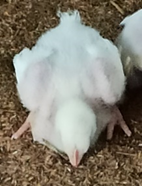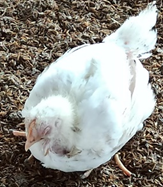INTRODUCTION
Poultry is one of the fast-growing segments of the agriculture sector in India and plays a vital role in fulfilling the protein requirements of the country. Poultry sector provides crucial support to the low economic classes of India through backyard farming, small-scale farming, and employment opportunities to low economic groups, while also presenting ample business opportunities for investors. Profitability of poultry rearing is usually affected by two major factors, viz. production cost and market rate of the product. Both the factors are affected to a great degree by the health and disease scenario of poultry. Various clinical and subclinical diseases are frequently encountered in poultry and decide the profit loss scenario for farmers. Incidence of diseases and their impacts on final profit is never been part of the initial calculation despite a high incidence of disease throughout the year. Hence, it becomes the difference between profit and loss in most of the cases.
In poultry farming many viral, bacterial, protozoan, fungal, nutritional, and metabolic diseases are frequently encountered. While most of these causes can be minimized through proper preventive measures, viral disease outbreaks stand highlighted because of the difficult preventive measures, emerging new variant strains and no available treatment to reduce the losses. In India, the contributing factors for viral outbreaks are unfavorable climate, inappropriate infrastructure, substandard managemental practices, and low awareness regarding biosecurity practices. Among the viral diseases of poultry, inclusion body hepatitis (IBH) and hydropericardium syndrome (HPS) are important diseases, causing significant losses in many countries including India, USA, Canada, Hungary, Korea, Japan, and China.
ETIOLOGY (CAUSATIVE AGENT)
IBH and HPS (also known as litchi heart disease) caused by fowl adenovirus belonging to the genus avian adenovirus of family adenoviridae. Fowl adenoviruses are classified into five species (A to E) and further into 12 serotypes (1 to 7, 8a, 8b, 9,10,11). Although all the serotypes are associated with the outbreak of IBH, the disease is primarily caused by serotype 7, 8a, 8b of species E and serotype 2 & 11 of species D. HPS outbreaks are mostly associated with serotype 4 of species C.
Fowl adenovirus is a non-enveloped icosahedral particle of 70-90 nm diameter. It has a linear double stranded DNA (deoxyribonucleic acid). All adenoviruses are resistant to lipid solvents, sodium deoxycholate, 2% trypsin, 50% alcohol, exposure to pH between 3 to 9, and high temperature (60-70° C for 30 minutes). However, they are inactivated by 1:1000 formalin.
IBH is characterized by low morbidity and high mortality (2 to 10%) in broiler chicken of 3-6-weeks of age, while, HPS has a higher mortality rate of 30-70%. In case of HPS, occurrence of hydropericardium (upto 10 ml clear or straw-colored fluid in pericardium) is frequently observed.
| Genus | Species | Serotypes | Disease |
| Aviadenovirus | Fowl adenovirus A | FAdV 1 | Gizzard erosion, IBH |
| Aviadenovirus | Fowl adenovirus B | FAdV 5 | IBH |
| Aviadenovirus | Fowl adenovirus C | FAdV 4 and FAdV 10 | FAdV 4 – HPS, IBH |
| Aviadenovirus | Fowl adenovirus D | FAdV 2,3, 9, 11 | IBH |
| Aviadenovirus | Fowl adenovirus E | FAdV 6,7, 8a, 8b | IBH |
| Atadenovirus | Duck adenovirus A | Duck adenovirus 1 | Egg drop syndrome |
| Siadenovirus | Turkey adenovirus A | Turkey adenovirus 3 | Turkey hemorrhagic enteritis |
Note: FAdV- Fowl Adenovirus.
EPIDEMIOLOGY AND PATHOGENESIS
Adenoviruses are pervasive and are isolated from sick and healthy birds. Epidemiological data indicate that most FAdV-4 infections occur during the hot and humid season, and sporadic outbreak during winter season. The disease was first reported in India from Jammu in 1994. Further, disease outbreaks have been reported from almost every part of the country, causing huge economic losses to poultry industry. During late 90s’, serotype FAdV-1 was prevalent but recently FAdV-4 is prevalent in many states of India. Vertical transmission is the vital route. Chicks hatching from infected eggs may excrete virus from the time of hatching, but typically chicks do not excrete virus until 2-4 weeks of age, presumably due to the presence of maternal antibodies, which do not allow reactivation of latent virus. In chicks originating from different parent flocks, interchange of strains may occur, and birds may be concurrently affected with more than one serotype of virus. Birds may re-excrete virus throughout life and hens frequently excrete virus during peak lay of production. Humoral antibody does not appear to play a role in preventing the excretion of virus. It acts in intraspecies protection which may be debatable. Few studies demonstrated that interspecies protection was offered by serotype 4 and serotype 8a but require further research. Horizontal transmission is also a vital route of transmission for IBH. A high load of infectious organisms is shed through droppings, transmission through bird to bird and vectors, which transmit the disease. Virus can be excreted through respiratory secretions and semen, however, the true aerosol transmission between farms is unlikely as the airborne transmission is for a short distance. Subclinical infections are due to the low virulence of strains or the presence of maternal antibodies.
CLINICAL SIGNS AND NECROPSY OBSERVATION
Generally, clinical cases of IBH are seen between 3 to 6 weeks of age. However, it is reported in flocks having 1-week age and up to 20 weeks pullet. IBH infection is characterized by the sudden onset of mortality with low morbidity, where mortality peaks between 3-4 days and ceases by day 5 to 6. But in some cases, mortality continues upto 3 weeks. Mortality is generally between 2 to 10%, which was observed to be 30% as well. Common clinical signs are crouching of birds, anaemia, dullness, depression, huddling with ruffled feathers, and mild greenish diarrhea.
Upon necropsy examination of bird liver is enlarged, pale yellowish, friable with scattered petechial and ecchymotic hemorrhage. Liver may show multifocal coagulative necrosis in few cases, with pale enlarged kidney. Bone marrow aplasia, gizzard erosion, necrotizing pancreatitis, atrophy of bursa and thymus is usually observed. In case of HPS, the hydropericardium condition along with liver and kidney lesions is observed and mortality may be 30-70%. Upon histopathological study, the cytoplasm of hepatocytes shows macrovacuolar to microvacuolar changes with the presence of intranuclear basophilic and eosinophilic inclusion bodies. Viral particles are observed inside the basophilic inclusions.

Figure-1: Crouching position in sick birds. 
Figure-1: Crouching position in sick birds. 
Figure-2: Hepatomegaly 
Figure-3: Hepatitis with necrosis and hemorrhage 
Figure-4: Kidney swollen with hemorrhage 
Figure-5: Trachea congestion 
Figure-6: Hydropericardium Syndrome
PREDISPOSING FACTORS AND COMPLICATIONS
Common predisposing factors for IBH are immunosuppressive diseases like CAV (chicken anemia virus), IBD (infectious bursal disease), and mycotoxicosis. Coccidiosis or metabolic diseases can also increase the risk of IBH infection. Mycotoxins like aflatoxin and ochratoxin are known to increase the pathogenicity of IBH. Concurrent infection with CAV increases the severity of disease. Studies have shown that interference with functions of bursa or damage of bursa increases the pathogenicity of IBH.
However, recent studies have suggested that in some cases, immunosuppressant factors may not be needed for induction of disease based on IBH in chickens. Findings suggested that certain FAdVs’ (FAdV-11) are pathogenic enough to primarily induce IBH in young broilers. Poor management practices like insufficient floor space, feeding and drinking space, and stress are predisposing factor.
PREVENTION AND CONTROL
IBH can be practically caused by any of the 12 serotypes, while HPS is caused by serotype 4 of fowl adenovirus. Due to little or no protection offered between species, the role of bivalent or multivalent vaccine to provide protection among species became vital. Although there are studies suggesting interspecies protection by monovalent vaccine strains, it is still debatable. Vaccine to parent stock has shown to pass protective titers to progeny and should be considered. Use of autogenous vaccine has been a common practice in past. But it has few limitations like the risk of disease spread in case of improper inactivation of virulent strains, poor biosecurity, unhygienic condition during production, lack of suitable adjuvants, and determination of appropriate quantity of virus. Live attenuated vaccines are effective but pose a threat of disease spread by virulence reversion. Study by Munir et al; concluded that salinomycin and monensin augmented the anti-HPS immune response in broiler chicken. Similarly, arginine in the diet enhanced protective immunity status in broiler chicken against HPS virus. Diuretics could be used to reduce the fluid accumulation in pericardial sac and liver tonic, whereas, haematinics, vitamin E and immunostimulant could be used to improve the health of affected flock.
Awareness and implementation of correct biosecurity measures can reduce the spread of virus among flocks. Physical and chemical deactivation of the virus through terminal disinfection, reduction of farm traffic, no exchange of materials among sheds and farms, foot bath, change of cloth, and footwear are the biosecurity practices that help to reduce the horizontal spread of disease. Maintaining the management related stress and mycotoxins, followed by appropriate control of other immunosuppressive diseases through proper vaccination reduce the incidence and pathogenicity of disease.
Public health significance: Fowl adenoviruses do not affect mammals naturally, therefore, no public health implication is known.
SUMMARY
Vaccination of parent stock with multivalent vaccines provides protective titers to broiler flock. If multivalent vaccine cannot be used, identification of prevalent serotype in the region and selection of vaccine as per prevalence can be practiced. The widely available vaccine serotype is FAdV4, which provides protection against HPS but offers little cross protection for other IBH serotypes. As pathogenicity of HPS is much higher than IBH, and FAdV4 is responsible for causing HPS if used as monovalent vaccine, using serotype 4 is sensible. Commonly available bivalent vaccine contains FAdV8 and FAdV11, and thus provides protection against common species E and D but provide little or no protection against HPS. Multivalent vaccine having serotypes 4, 8 and 11 provide protection against species C, D and E offering broad protection. Use of an autogenous vaccine can provide a satisfactory but unpredictable immune response and has its own limitations.
Both humoral and cell-mediated immunity are vital in giving protection against diseases, therefore, well-developed immune system is the best defense against viral infections. Use of Kemin solutions help to maintain immune system and provide protection against the viral outbreaks. Aleta™, an immunomodulator in feed enhances the innate immunity and help to attain higher vaccine titers by the activation of immune system. DURIM™ can be used as an immunomodulator through water to achieve high vaccine titers and reduces the stress on birds. Inactivation of virus and reduction of viral load among flocks and sheds are vital. Adenovirus is susceptible to inactivation by the aldehyde group. Thus, Keciddal™ T Plus is the best choice for terminal disinfection of sheds, vehicle wash as well as for regular spray in the presence of birds. Use of quality raw material and high-quality toxin binders reduces the load of mycotoxins. Hence, TOXFIN™ can be used to minimize toxin exposure to birds. Avoiding setting the eggs from heterogenous breeder flocks prevents the concurrent infection of several serotypes.
To conclude, IBH and HPS pose a higher threat to poultry economics. To minimize the damage, achieve an optimum innate and specific immune response, practice high biosecurity practices, high feed safety standards, and standard managemental practices.
Dr Ajay Kumar, Dr Venket M Shelke and Dr Partha Das
Kemin Industries South Asia Pvt. Ltd.